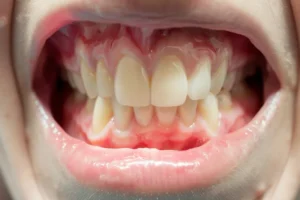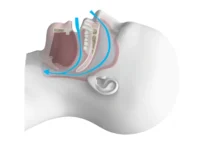Acute gingivitis is a common oral health condition characterized by inflammation of the gums, which can cause redness, swelling, and sometimes bleeding during brushing or flossing. This dental issue is primarily triggered by the buildup of plaque, a sticky film of bacteria that forms on the teeth and gums. If not removed through regular brushing and flossing, plaque can harden into tartar, exacerbating gum irritation and leading to more severe stages of gum disease. This article delves into the symptoms of acute gingivitis, explores its main causes, and offers effective strategies for prevention and management.
What is Acute Gingivitis?
Definition and Overview
Acute gingivitis is a form of gum disease characterized by sudden onset and severe inflammation of the gums. Unlike chronic gingivitis, which develops slowly over time, acute gingivitis can appear rapidly, often within days. It is primarily caused by the accumulation of plaque, a sticky film of bacteria that forms on the teeth. When left untreated, acute gingivitis can progress to more serious forms of periodontal disease.

Understanding the difference between acute and chronic gingivitis is crucial for proper diagnosis and treatment. While both conditions involve gum inflammation, the acute form often requires more immediate attention due to its rapid development and potential to cause significant discomfort. Proper oral hygiene and regular dental cleanings are essential in preventing both forms of the disease.
Acute gingivitis can affect anyone, but it is more commonly seen in individuals who neglect their oral hygiene, smoke, or have certain medical conditions that weaken the immune system. Early detection and intervention are key to managing this condition effectively.
Signs and Symptoms
The signs and symptoms of acute gingivitis are often more pronounced than those of chronic gingivitis. Key indicators include red, swollen gums that may bleed easily when brushing or flossing. A person with acute gingivitis might also experience pain or discomfort in the gums, especially when chewing or consuming hot, cold, or spicy foods.
Other symptoms include:
- Bad breath (halitosis)
- Receding gums
- Visible plaque buildup
- Sensitive teeth
In some cases, individuals may notice a change in the color of their gums, ranging from bright red to a purplish hue. This discoloration is due to the increased blood flow and inflammation in the affected areas. Regular dental check-ups can help identify these symptoms early, making treatment more effective.
Complications
If left untreated, acute gingivitis can lead to more severe complications, including periodontitis. Periodontitis is an advanced form of gum disease that can cause the gums to pull away from the teeth, leading to the formation of pockets that can become infected. Over time, this can result in the loss of bone and tissue that support the teeth, potentially leading to tooth loss.
Additionally, acute gingivitis has been linked to other health issues. Studies have shown a connection between gum disease and systemic conditions such as heart disease, diabetes, and respiratory infections. The inflammation associated with gingivitis can contribute to the overall inflammatory burden on the body, exacerbating these conditions. Preventing complications involves maintaining good oral hygiene practices, including:
- Brushing teeth at least twice a day
- Flossing daily
- Using an antibacterial mouthwash
- Regular dental check-ups and cleanings
By following these steps, individuals can significantly reduce their risk of developing acute gingivitis and its associated complications.
Understanding acute gingivitis and its potential impacts is crucial for maintaining good oral health. For more insights into dental health and treatment options, be sure to explore our other articles on related topics.
Causes of Acute Gingivitis
Acute gingivitis is a common and often painful condition that affects the gums. Understanding the underlying causes of this condition is crucial for effective prevention and treatment. While various factors can contribute to acute gingivitis, certain causes are more prevalent and have been extensively studied. Identifying these can help individuals adopt better oral care habits and seek timely professional intervention.
Acute gingivitis primarily results from the buildup of plaque on teeth surfaces, but there are several contributing factors that can exacerbate this condition. Below, we explore some of the most common causes, including poor oral hygiene, bacterial infections, and other contributing factors.
Poor Oral Hygiene
One of the most significant causes of acute gingivitis is poor oral hygiene. Failure to maintain a consistent oral care routine allows plaque—a sticky film of bacteria—to form on the teeth and gums. Over time, this plaque can harden into tartar, which is much more difficult to remove and can irritate the gums, leading to swelling, redness, and bleeding.
To prevent the onset of acute gingivitis, it is essential to follow a strict oral hygiene regimen:
- Brush your teeth at least twice a day with fluoride toothpaste
- Floss daily to remove food particles and plaque between teeth
- Use an antiseptic mouthwash to reduce bacteria
- Replace your toothbrush every three to four months
Adopting these habits can significantly reduce the risk of developing acute gingivitis and other dental issues. Regular dental check-ups are also vital for maintaining oral health and catching any potential problems early.
Bacterial Infections
Bacterial infections are another common cause of acute gingivitis. Specific bacteria, such as Porphyromonas gingivalis and Treponema denticola, have been identified in the development of periodontal diseases. These bacteria produce toxins that can damage the gum tissue, triggering inflammation and infection.
Gingivitis caused by bacterial infections can often be identified by symptoms such as:
- Swollen, tender gums
- Bleeding during brushing or flossing
- Persistent bad breath
- Formation of deep pockets between the teeth and gums
Immediate treatment consists of improved oral hygiene practices and professional cleaning. In some cases, antibiotics may be prescribed to eliminate the infection and reduce inflammation. Recognizing the signs of bacterial infection early and seeking appropriate treatment can prevent the progression to more severe periodontal diseases.
Other Contributing Factors
While poor oral hygiene and bacterial infections are the primary causes of acute gingivitis, other factors can also contribute to the condition. For example, hormonal changes during pregnancy, puberty, or menopause can make gums more sensitive and susceptible to inflammation. Certain medications, such as antihistamines or antidepressants, can reduce saliva flow, which helps protect the gums.
Additionally, lifestyle choices such as smoking and poor diet can weaken the body’s immune response, making it harder to fight off infections and maintain healthy gums. Smoking, in particular, significantly increases the risk of gingivitis and other periodontal diseases due to its impact on blood flow and immune function.
Other contributing factors include:
- Chronic illnesses like diabetes
- Genetic predisposition
- Stress, which can impair immune function
- Bruxism (teeth grinding), which can damage gum tissue
Addressing these contributing factors involves a holistic approach to health, encompassing both professional dental care and lifestyle changes. Regular dental visits, along with good personal habits, can make a significant difference in preventing and managing acute gingivitis.
Understanding the various causes of acute gingivitis is the first step towards effective prevention and treatment. For more information on related topics, be sure to explore our other articles on oral health and wellness.
Diagnosis of Acute Gingivitis
Acute gingivitis is a common oral health issue characterized by the inflammation of the gums. Early diagnosis is crucial to prevent the progression to more severe periodontal diseases. Dentists employ a combination of clinical examination, dental history, and various tests and procedures to accurately diagnose acute gingivitis.
In this section, we will delve into the key components of diagnosing acute gingivitis, including clinical examination, dental history, and specific tests and procedures. Each of these elements provides critical insights that help in the formulation of an effective treatment plan.
Clinical Examination
The clinical examination is the cornerstone of diagnosing acute gingivitis. During a clinical examination, the dentist will visually inspect the patient’s gums for signs of inflammation, such as redness, swelling, and bleeding. These symptoms are often the initial indicators of gingivitis.
The dentist will also use a periodontal probe to measure the depth of the gingival pockets. Pockets deeper than 3mm are generally indicative of some form of gum disease. The texture and color of the gums are also assessed during this examination to identify any abnormalities.
Plaque and tartar buildup are additional focal points during a clinical examination. Plaque, a sticky film of bacteria, is the primary cause of gingivitis. When plaque hardens, it turns into tartar, which can further exacerbate gum inflammation if not removed.
Dental History
Understanding the patient’s dental history is essential for diagnosing acute gingivitis. The dentist will inquire about oral hygiene habits, such as brushing frequency and technique, flossing, and the use of mouthwash. Poor oral hygiene is a leading contributor to gingivitis and other periodontal diseases.
A detailed history will also include questions about the patient’s dietary habits. A diet high in sugar and carbohydrates can promote the growth of plaque-causing bacteria. The dentist may also ask about smoking habits and alcohol consumption, as both are risk factors for gum disease.
Previous dental procedures and treatments are also pertinent. For instance, any history of scaling and root planing or other periodontal treatments can provide insights into the patient’s susceptibility to gingivitis.
Tests and Procedures
Additional tests and procedures can provide more in-depth information for a definitive diagnosis. Common diagnostic tests include X-rays, which can reveal bone loss and the extent of tartar buildup below the gumline. X-rays are particularly useful for assessing the severity of gingivitis and its progression to periodontitis.
In some cases, a bacterial culture may be taken to identify specific pathogens contributing to the inflammation. This can help in tailoring antibiotic treatments if necessary. Salivary diagnostics is another emerging field that can provide valuable information about the state of the oral microbiome and its role in gingivitis.
Blood tests might also be conducted to rule out systemic conditions that could be affecting gum health, such as diabetes or vitamin deficiencies. These tests are crucial for a comprehensive understanding of the patient’s overall health and its impact on oral hygiene.
Accurate diagnosis is the first step in the effective management of acute gingivitis. For more in-depth information on treatment options and preventative measures, be sure to explore our other articles on oral health.
Prevention and Treatment of Acute Gingivitis
Preventive Care
Preventive care is crucial in maintaining oral health and avoiding the onset of acute gingivitis. This includes a combination of good daily practices and regular professional check-ups. Brushing teeth at least twice a day with fluoride toothpaste and using dental floss to remove plaque from areas your toothbrush can’t reach are fundamental steps. Plaque buildup is the primary cause of gingivitis, and addressing it daily is essential.
It is also important to schedule regular dental cleanings, typically every six months, to remove hardened plaque (tartar) that cannot be eliminated by brushing and flossing alone. A balanced diet rich in vitamins, especially vitamin C and calcium, plays a significant role in maintaining healthy gums. Proper hydration and avoiding tobacco products can further reduce the risk of gingivitis.
Professional Treatments
If acute gingivitis is diagnosed, professional treatments are necessary to address the condition comprehensively. The first step usually involves a thorough dental cleaning known as scaling and root planing. This procedure removes plaque and tartar from above and below the gum line and smooths out the tooth roots to help the gums reattach to the teeth.
In some cases, antimicrobial mouth rinses or topical antibiotics may be prescribed to control bacterial infection. For more severe cases, systemic antibiotics might be necessary. The dentist might also suggest a follow-up visit to monitor the healing process and ensure that the gums are responding to the treatment.
- Scaling and root planing
- Antimicrobial mouth rinses
- Topical or systemic antibiotics
- Follow-up visits
Home Remedies
Along with professional treatments, certain home remedies can support the healing process and alleviate symptoms. Saltwater rinses can help soothe inflamed gums and kill bacteria. To make a saltwater rinse, dissolve half a teaspoon of salt in a glass of warm water and rinse your mouth for 30 seconds a few times a day.
Another effective home remedy is using hydrogen peroxide as a mouth rinse. Mix equal parts 3% hydrogen peroxide with water and rinse your mouth for about 30 seconds. This helps in reducing plaque and promoting gum health. Additionally, applying aloe vera gel to the gums can reduce inflammation and promote healing.
Maintaining excellent oral hygiene at home is essential for preventing the recurrence of gingivitis. Continue brushing and flossing diligently, and consider using an antimicrobial mouthwash regularly. Avoid foods and drinks that can irritate the gums, such as those high in sugar and acidity.
For more detailed insights into dental health, explore our other articles that delve into various aspects of oral care and advanced treatments.
Common Questions About Acute Gingivitis
If you’re looking to expand your understanding of acute gingivitis, you likely have some questions. Below you’ll find a commonly asked question along with its answer to help clarify your concerns.
What are the primary symptoms of acute gingivitis?
The primary symptoms of acute gingivitis include red and swollen gums that may bleed easily when brushing or flossing. You might also notice bad breath or a bad taste in your mouth. If the conditions persist, it’s important to consult a dental professional to prevent progression to more serious gum diseases.

My name is Salman Kapa, a 73-year-old expert in bone regeneration and dental implantology. With decades of experience in the field, I am dedicated to advancing our understanding of oral health and hygiene. Through my research and writing, I aim to contribute to the development of innovative solutions in dental care.




